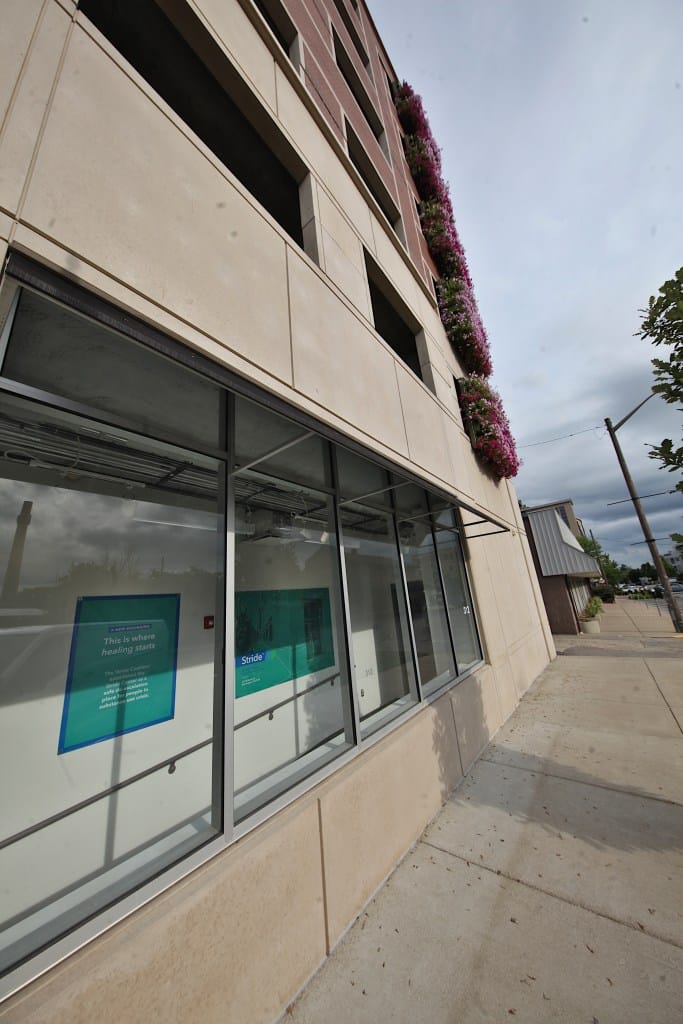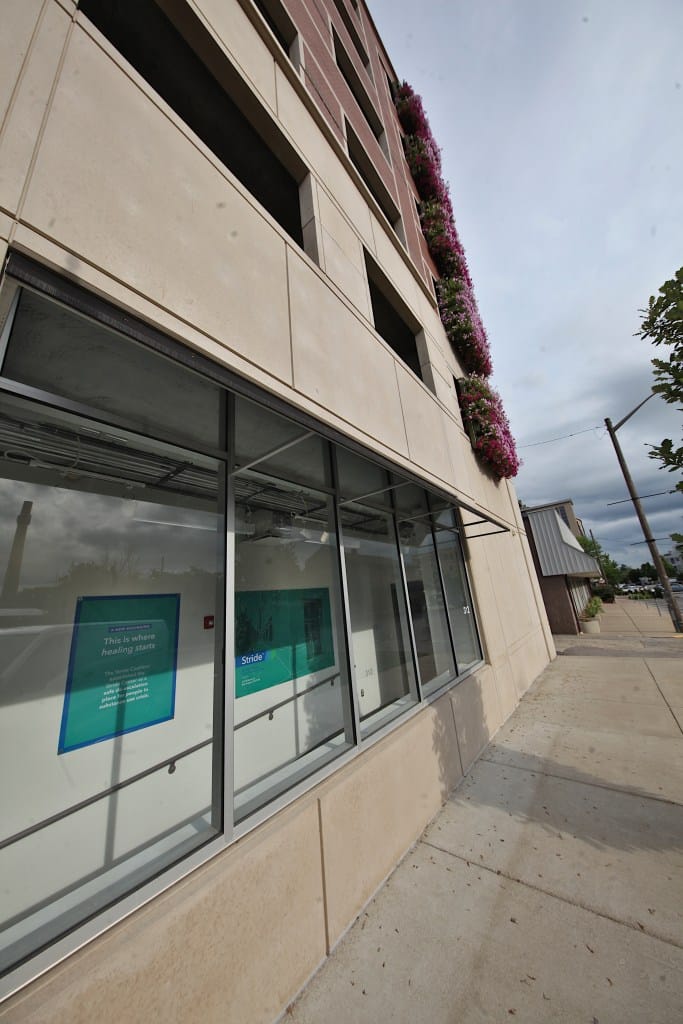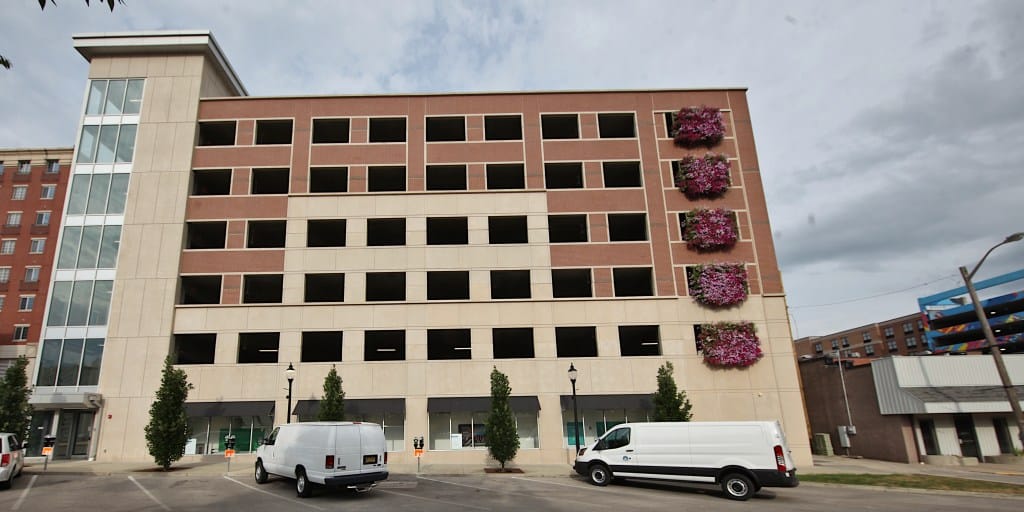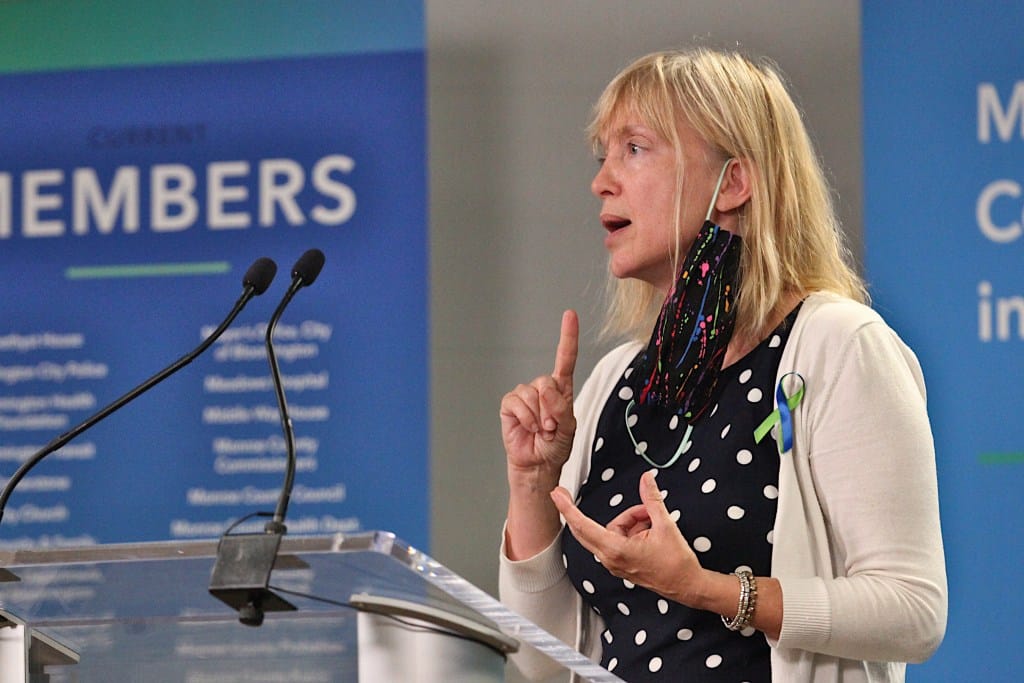Not a jail or a hospital: Stride Coalition’s crisis diversion center gets ribbon cut ahead of Aug. 3 opening




On Monday afternoon, leaders of several local organizations gathered on the lower level of Monroe County’s Morton Street Parking garage for a crisis diversion center ribbon cutting.
The space was originally designed as a place for inmates of the county jail—a place they could be housed in case the jail needed to be evacuated. The jail is just across the alley to the west.
Now it’s been remodeled as a place where people who are in trouble can be taken by law enforcement officers, instead of the jail. Or a hospital.
With the ribbon now cut, the Stride Coalition’s crisis diversion center is expected to be fully staffed and ready to open by Aug. 3, according to Linda Grove-Paul, vice president of adult and family services at Centerstone, the lead organization for the Stride facility.
The new facility is based on the idea that neither the jail nor a hospital emergency room can provide a good solution for someone late at night when that person is in the middle of a mental health or substance use crisis.
It’s a solution to what Bloomington’s mayor John Hamilton called “the 2 a.m. problem.”
Pete Yonkman, president of Cook Group and Cook Medical, said that the coalition has been working for two years to plan and fund the new center. They invited a police officer to share his perspective on the issue. “[The police officer] said, … when we’re called to a scene at 2 a.m. … Many times the person that we’re dealing with is in the middle of a mental health or drug crisis. He said, we have the option to take this person to prison, jail, or we can take them the emergency room. And really, neither of those places are the right place for that person.”
The center will be staffed 24/7, with at least two people at all times, according to January Whittaker, who’ll be working as a peer support specialist at the center. The full staff will include three specialists, three recovery coaches, two LPNs, a therapist and a coordinator—around 10 people in all.
Brian Shockney, who’s president of IU Health’s south central region, said that in the six weeks from June 1 to July 16, the IU health care team cared for 252 patients in crisis. A large number of them could have instead visited the Stride crisis diversion center, Shockney said.
The crisis diversion approach does not remove law enforcement officers from the equation—as some in the community have been asking, under the slogan “defund the police.”
It’s only law enforcement officers who can refer people to the center.
So law enforcement will be key to the success of the center. Bloomington police chief Mike Diekhoff told The Square Beacon, “I wish everybody else realized that as they talk about defunding law enforcement.”
About the possibility that the center could be opened up to community- or self-referral, Diekhoff said he think that will probably happen—eventually. He added, “That’s not my decision to make, that’s Centerstone’s decision.”
After the ribbon cutting, Monroe County councilor Geoff McKim told The Square Beacon that there’s going to be a role for law enforcement to play. About the idea that law enforcement officers could be taken completely out of the equation, McKim said, “I just don’t see where that’s going to happen.”
As an example, McKim gave parents whose son is getting violent, because he’s off his meds, and they need him to be taken away from their situation. “They’re still going to call the police,” he said. There is a reason to have the police involved, McKim said, but only to provide the services that law enforcement really should be providing.
McKim added, “By providing additional options and channels to get help, we would ideally reduce the need for the police to even be involved in such situations at all.”
The community support for the center includes a long list of organizations, including Cook Medical, Bloomington Health Foundation, Community Foundation of Bloomington and Monroe County, and the Monroe County and Bloomington governments.
Shockney said IU Health Foundation has dedicated a total of $1,050,000 over three years to help operate the center. County commissioner Lee Jones told the group at the ribbon cutting that in addition to providing the physical space for the center, the county government will be paying for the utilities used by the center.
Excerpts from remarks
The Monroe County Substance Use Disorder Coalition was formed in March 2018 in response to the devastating impact that substance use disorder was having and is having in Monroe County and surrounding communities. By communicating an overarching vision that provides alignment and common purpose for all groups who are actively addressing substance misuse in our community, the coalition works to bring together the people who are working to break down barriers that prohibit these groups from meeting their goals. And as president of the Bloomington Health Foundation, I have witnessed firsthand how, when a community comes together in support of a common purpose, as we have with our Stride Coalition, so much of what perhaps previously seemed impossible, comes quickly into focus as what is possible
Jon Barada, president and CEO of the Bloomington Health Foundation
One of things I say, as a government person, is you can describe government sometimes in five words, what government ought to do. Pick important problems, period. Fix them. Sometimes problems pick you, too, that can happen. … [O]ne of the ways it was described in this in this coalition was the 2 a.m. problem. The 2 a.m. problem is what happens to a person whose life has not gone well that day or that week or for some time, what happens at 2 a.m. when they have a crisis. And the problem is, mostly we have two choices. That person can be taken to a hospital, or that person can be taken to the criminal justice system to a jail. And those two choices don’t fill in the need to how to fix that problem.
John Hamilton, mayor of the city of Bloomington
The Stride Center will allow our local law enforcement agencies to divert nonviolent offenders and other people who’ve come into police contact, because of their mental health or substance use crises. They’re going to be diverted away from jail or the hospital and into treatment services that could prevent such future contact.
Erika Oliphant, Monroe County prosecutor
And as we engage this conversation, I think it’s really important that we take a moment to step back and appreciate the work that Bloomington and Monroe County have already done in this area. Just as some examples, our police departments have implemented a program of downtown resource officers and specialists. We have neighborhood resource specialists, who are working directly with our community. Our judges have developed alternative drug courts and programs that help people avoid prison and a criminal background record. And our prosecutor and probation departments actively seek ways to minimize the burden of court fees on people trying to reenter our communities. … Today, we’ve reached a significant milestone with the opening of the Stride Center. It’s a pre-arrest option for our first responders in a safe place for people who are struggling with mental health and substance use disorders. The center is the first fully operational center of its kind in Indiana. Its mission is to help people stay out of the judicial system, and to connect them to healthcare professionals and resources.
Pete Yonkman, president of Cook, Group and Cook Medical
In this world, life doesn’t make any sense without interdependence. We need each other. And the sooner we learn that, the better for us all. …Through the Stride Center people in our community, now have 24 hour Crisis Center care to go to when they need help.
Brian Shockney, president of IU Health’s south central region
This is just the next step. We now have a place that we can take people 24 hours a day, they don’t belong in jail. They don’t necessarily belong in the emergency room. Centerstone has been a very long time partner with the city of Bloomington police department. From when we first started the DRO program, they were there to help us.
Mike Diekhoff, chief of Bloomington police
The county’s role in it has been to provide the space, this wonderful space that has been completely transformed from what it looked like originally. …We are delighted that it has been located on county property. …My mother spent the last 40 years of her life dedicating many, many hours of her time to prison and jail issues. She visited the Monroe County jail on a weekly or more frequent basis, getting to know many of the inmates well, and understanding that as people they were so much more than just prisoners … I know my mother would be so proud of our entire community for taking this issue on and trying to bring the way we deal with it out of the 17th century and into a new, more empathetic way of treatment and support.
Lee Jones, Monroe County commissioner
My name is January. I’m a recovery specialist here at the stride center. I’m a recovering addict. I was in active addiction for five years of my life. I did not wake up one day and decide I was going to become a drug addict. But I did make the decision to use drugs. I thought I could control it, but eventually realized, by that time I had lost control. I had also lost everything in my life, family, friends, my home, but most of all, I lost myself. … I wish there had been a place like the Stride Center when I was in those dark times, a place that could have turned to knowing that no one was judging me, but a place that would help me find a program or help me find shelter and food, a place that believed in me when I didn’t believe in myself. And I hope that all of us at the Stride Center can be that hope that others may need.
January Whittaker, a peer support specialist at the stride center
It’s been three years, a long time coming. We visited places all over the country. We’ve had calls with folks all over the country, we’ve consulted with experts, and this is really as a community what we came to, in terms of what we really need. It’s a piece, it’s not the whole, you know, part of the puzzle. But this is one one piece that’s been missing.”
Linda Grove-Paul, vice president of adult and family services at Centerstone
Photos
Click to view slideshow.



Comments ()